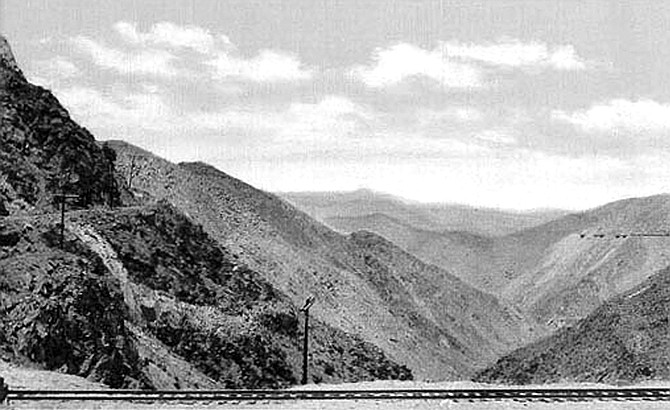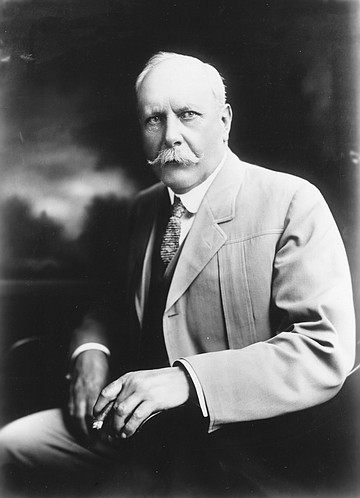 Facebook
Facebook
 X
X
 Instagram
Instagram
 TikTok
TikTok
 Youtube
Youtube

"I am a businessman, not a Santa Claus, nor a damn fool.”
That’s a quote from John D. Spreckels (1853–1926), who once owned so much of San Diego that he paid 10 percent of its total property taxes. For starters, all of North Island used to be his. So were several local transportation systems, including the streetcar line. Hotel del? Check. Coronado Water Company? Ditto. San Diego–Coronado Ferry? That, too. San Diego Union? Every magnate needs a newspaper. Having come from money (his father was a sugar king), he went ahead and made more. He did suffer one significant business failure in his lifetime, however: the San Diego & Arizona Railroad.

Spreckels’s 140-mile mistake is the focus of this weekend’s living-history program at the model-railroad museum. It will consist of 15 scenes in which actors play Spreckels and other historic personages involved in the history of that railroad.
Hal Ritz, the event’s organizer, said that these actors would be model railroad club members wearing period clothes and posed with antique furniture against painted backdrops. He and a 12-year-old member of the club painted one of those backdrops.
Bruce Semelsberger will play Spreckels’s chief engineer of construction, Edmund J. Kallright. Semelsberger is the amateur historian who appeared on the public television program about the so-called “Impossible Railroad” a few years ago. The railroad got its nickname, said Ritz, because between the place where ground was broken for the line in 1906, near the foot of 28th Street, and the eastern terminus, in El Centro, there was never land more ill-suited for train tracks. For the crossing of the Carrizo Gorge alone, a mere 11 miles, 14 trestles and 21 tunnels were required.
To build the railroad took 13 years, much longer than Spreckels had anticipated. A massive flood caused one period of delay. San Diegans believed that Charles M. Hatfield was responsible for that flood, and someone will play him this weekend. “Hatfield was, of course, the rainmaker,” said Ritz. “He was hired by San Diego to produce rain in 1916, during the very bad drought. And so he got his chemicals together and went out to the desert, and conjured. And in a few days, believe it or not, it rained. And it rained. And then it rained some more.” Before the rain ended, the flood that Hatfield had seemingly produced had washed out newly constructed train bridges. (It also washed out auto bridges and finally even broke the Otay dam.)
Many of the railroad’s laborers were Chinese immigrants. “And so we’re going to have the Chinese connection,” said Ritz, “to be presented by the San Diego Chinese Historical Museum under the leadership of Dr. Alexander Chuang.” Ritz calls the Chinese the railroad’s “unsung heroes,” but new evidence suggests that labor problems were perhaps the major reason why the railroad took so long to be built.
The route of the San Diego & Arizona dipped down into Mexico before reentering California on its way east. The inhospitable terrain had dictated it. But during the period when those tracks were being laid, lawlessness prevailed: the Mexican Revolution was taking place. “Most of the action was occurring in the Mexico City area,” said Ritz, “but it left a power vacuum up here.” So there will be a scene in which a train is held up by club members playing banditos.
The Mexican route also gave Ritz and the others a reason to include “the Hollywood connection,” and he promised that a couple of members would be playing generic movie actors. “That’s because many stars of the day traveled on the train down to Agua Caliente, which was a gambling place south of the border.”
In 1928, Paramount Pictures produced a silent film, Beggars of Life, “which is about the railroad and the hobos,” said Ritz. “We’re showing the actual movie continuously. So people can drop in there” — in a corner of the museum that’s been fitted out as Spreckels Theater.
When the railroad was finally completed in 1919, it was one of the last links in the transcontinental line, and, at nearly $19 million, one of the most expensive. What’s left of it today is “a little portion in Campo,” said Ritz. It’s run by the Pacific Southwest Railway Museum (the one for full-size trains). “It only goes a few miles — an excursion train.” For tourists? “Sadly, yes. There’s talk of running freight on it again, but that’s a long way off.”
Besides educating the public, another reason the museum sponsors this annual program, said Ritz, is “to let the public know we’re not just a bunch of grown men down here playing with toy trains.” But if they or younger enthusiasts don’t feel compelled to justify that pleasure, they’ll be free to ignore the history lessons and just have fun with the models rolling through the miniature scenery.


"I am a businessman, not a Santa Claus, nor a damn fool.”
That’s a quote from John D. Spreckels (1853–1926), who once owned so much of San Diego that he paid 10 percent of its total property taxes. For starters, all of North Island used to be his. So were several local transportation systems, including the streetcar line. Hotel del? Check. Coronado Water Company? Ditto. San Diego–Coronado Ferry? That, too. San Diego Union? Every magnate needs a newspaper. Having come from money (his father was a sugar king), he went ahead and made more. He did suffer one significant business failure in his lifetime, however: the San Diego & Arizona Railroad.

Spreckels’s 140-mile mistake is the focus of this weekend’s living-history program at the model-railroad museum. It will consist of 15 scenes in which actors play Spreckels and other historic personages involved in the history of that railroad.
Hal Ritz, the event’s organizer, said that these actors would be model railroad club members wearing period clothes and posed with antique furniture against painted backdrops. He and a 12-year-old member of the club painted one of those backdrops.
Bruce Semelsberger will play Spreckels’s chief engineer of construction, Edmund J. Kallright. Semelsberger is the amateur historian who appeared on the public television program about the so-called “Impossible Railroad” a few years ago. The railroad got its nickname, said Ritz, because between the place where ground was broken for the line in 1906, near the foot of 28th Street, and the eastern terminus, in El Centro, there was never land more ill-suited for train tracks. For the crossing of the Carrizo Gorge alone, a mere 11 miles, 14 trestles and 21 tunnels were required.
To build the railroad took 13 years, much longer than Spreckels had anticipated. A massive flood caused one period of delay. San Diegans believed that Charles M. Hatfield was responsible for that flood, and someone will play him this weekend. “Hatfield was, of course, the rainmaker,” said Ritz. “He was hired by San Diego to produce rain in 1916, during the very bad drought. And so he got his chemicals together and went out to the desert, and conjured. And in a few days, believe it or not, it rained. And it rained. And then it rained some more.” Before the rain ended, the flood that Hatfield had seemingly produced had washed out newly constructed train bridges. (It also washed out auto bridges and finally even broke the Otay dam.)
Many of the railroad’s laborers were Chinese immigrants. “And so we’re going to have the Chinese connection,” said Ritz, “to be presented by the San Diego Chinese Historical Museum under the leadership of Dr. Alexander Chuang.” Ritz calls the Chinese the railroad’s “unsung heroes,” but new evidence suggests that labor problems were perhaps the major reason why the railroad took so long to be built.
The route of the San Diego & Arizona dipped down into Mexico before reentering California on its way east. The inhospitable terrain had dictated it. But during the period when those tracks were being laid, lawlessness prevailed: the Mexican Revolution was taking place. “Most of the action was occurring in the Mexico City area,” said Ritz, “but it left a power vacuum up here.” So there will be a scene in which a train is held up by club members playing banditos.
The Mexican route also gave Ritz and the others a reason to include “the Hollywood connection,” and he promised that a couple of members would be playing generic movie actors. “That’s because many stars of the day traveled on the train down to Agua Caliente, which was a gambling place south of the border.”
In 1928, Paramount Pictures produced a silent film, Beggars of Life, “which is about the railroad and the hobos,” said Ritz. “We’re showing the actual movie continuously. So people can drop in there” — in a corner of the museum that’s been fitted out as Spreckels Theater.
When the railroad was finally completed in 1919, it was one of the last links in the transcontinental line, and, at nearly $19 million, one of the most expensive. What’s left of it today is “a little portion in Campo,” said Ritz. It’s run by the Pacific Southwest Railway Museum (the one for full-size trains). “It only goes a few miles — an excursion train.” For tourists? “Sadly, yes. There’s talk of running freight on it again, but that’s a long way off.”
Besides educating the public, another reason the museum sponsors this annual program, said Ritz, is “to let the public know we’re not just a bunch of grown men down here playing with toy trains.” But if they or younger enthusiasts don’t feel compelled to justify that pleasure, they’ll be free to ignore the history lessons and just have fun with the models rolling through the miniature scenery.
Comments